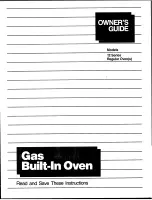
GB-12
●
Microwave ovens cook food using microwave
energy that is similar to naturally occurring radio
waves. Normally, these “waves” would fade as
they dispersed into the atmosphere but in a mi-
crowave oven they are concentrated onto food
causing it to heat up.
●
Microwave energy cannot pass through metal
– so it cannot escape from inside your micro-
wave oven – but it can pass through materials
like glass, porcelain, plastic and paper.
These materials are used in the manufacture of
microwave safe cooking equipment.
●
Microwave safe cooking equipment will still get
hot as the food it contains heats up.
The microwave energy focuses on the moisture in
the food causing lots of tiny vibrations. The vibra-
tions get so great that the moisture, and the food
heats up. (Fig 1)
Checking your cooking utensils
Most heat-resistant, non-metallic cooking utensils
are safe to use in your microwave. If you are not
sure if you can use a utensil in your microwave,
follow this simple test:
1.
Put the utensil into the oven next to a cup of
water – use a cup that you know is microwave-
safe. Close the door.
2.
Make sure that the grill is positioned in the
upwards position to the top of the microwave
(Do not use your hands to touch the grill as it
may already be hot). Turn the microwave oven
on for 30 seconds only.
3.
At the end of the time, carefully check to see if
the water has warmed up.
If the water has not warmed up but the utensil
has, the utensil is not microwave-safe and
should not be used in the oven.
1
Hitachi HIT BG17SS_IB_01GB_RC_Final121113.indd 12
13/11/12 4:18 PM













































